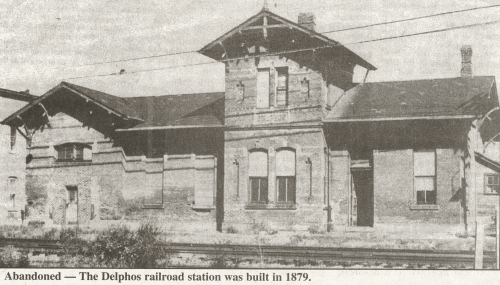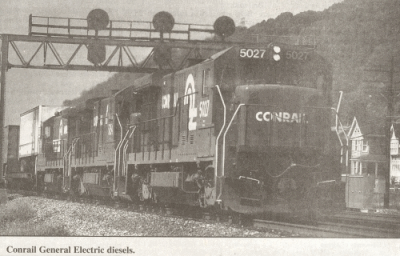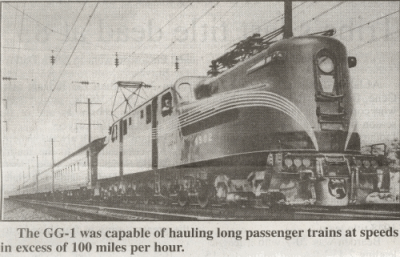
Window to the Past
Section of Pennsylvania Railroad begins in Delphos
By BOB HOLDGREVE
Letter written in 1896 by Jesse Straughan, engineer, tells of problems in construction of the road.
Some idea of the methods used and the conditions met within the days of the first railroad west through this district may be gained from the following letter written by Jesse Straughan to his friend John Burkett, then agent for the Pennsylvania at Delphos:
Dear Sir;
"Your recent communication to the "Daily Herald" commemorating
the opening of the Ohio and Indiana R.R. 42 years ago, brings to mind many
additional recollections, for as Chief Engineer of the company I was the one who
located and constructed the road and acted as its Superintendent until its
consolidation as part of the P.F.T.W. & C.R.R. Every part of this whole line
from Pittsburgh to Chicago has in my memory interesting episodes, for I was the
first person to run all the exploration lines and personally located all of this
line from Alliance to Chicago, and superintended the construction thereof
(except a little of the west end) traveling over the whole distance many times
on foot, sleeping or eating dinners at almost every farm house then existing on
or near the line, and was in close touch with the Board of Directors of each of
three companies up to and including the period of consolidation.
"The financial struggle that each of these companies had to meet and contend with were constant and almost overpowering on several occasions, the history of which will probably never be more than partially related. At Delphos we were much assisted by the friendly cooperation of every business man in the place, among those I remember Father Bredeick with especial gratitude, for we had to occupy a part of his grave yard, and portion of several out lots which was secured by his assistance, without expense to the company. The two White brothers, who constructed the basin (canal) and brought the iron from Toledo to Delphos to lay about twenty miles of track. They were poor but very industrious, late and early, mud and water fellows, and when they wanted the contract to bring the rails by canal, their boat and horses so poor and shabby, and they themselves so broken down with ague, we were loath to give them the contract, but we did, and they performed it well. Several years later, I was accosted in a hotel in New York City by a fine looking business-like gentleman who claimed to know me. It was one of the White brothers and he was manufacturing India rubber goods of all kinds from penholders to army pontoons. He took me to the establishment of his brother — on another street, who was manager of an establishment manufacturing structural iron work, including iron bridges for railroads. He was also a fine looking gentleman, and their own mother could not have recognized them as the same men who dug the Delphos canal basin.
"I take pride in the drawbridge too, for it was my own invention, and the first of its kind ever constructed, nor anything even slightly resembling it. All the drawbridges in Ohio were costly and as we had no money, its invention may be said a necessity, for this one cost considerably less than $100: the woodwork being done by one of your carpenters and the iron work by one of your blacksmiths located down near the canal locks.
"Another occurrence remains still strongly in my memory in which I was the sole actor. Between Delphos and Van Wert, was a bridge about 24 ft. span, the center being supported by king post and braces like the central panel of a Howe truss bridge. Our train was a long one, and I expected a wild engine following us with Judge Hana on board, who had been accidentally left at Forest. I got down on the lower step of the forward passenger car, and holding to both handles, I was leaning out as far as I could, looked back and not thinking of this little bridge which my head struck while we were running (as engineer Strope afterwards said) about 18 miles per hour. I was knocked senseless but my hands still held the grip for a moment when I fell headlong onto the soft earth of a newly made embankment. Consciousness did not return until midnight when I found myself in bed at Pliney Hoagland’s house, and two physicians were there who had been waiting for nine hours for signs of resuscitation, a longer time than either of them had ever before known. Notwithstanding this, I returned to Crestline the next day and soon had the satisfaction of reading my own obituary in some of the journals of eastern Ohio.
"Lot Dixon was my chief assistant engineer who started the construction of your draw bridge; he died at Bucyrus about that time, highly respected by everybody. Mr. S.B. Coe, head carpenter, supervised the completion of the bridge.
"Mr. Colwell and Mr. Fletcher who had the contract for track laying, are both living. Forty-two years have made greater changes than people can imagine. Van Wert County had less than 5,000 population and there was hardly a farm house in sight of the track between Delphos and Van Wert. (Probably, partly because the woods was so thick back then. R.H.) I stopped one night at Conn’s tavern at Van Wert, was given a room upstairs. Soon I heard a racket at the kitchen door and the scream of a woman. I looked out the window and saw a bear getting out of the lot over the fence. Off it went to the southwest, dogs following, but it was soon in the brush of the swamp. Near the state line I caught a pair of cubs who were too young to crawl over the iron rail and too big to crawl under it to follow their mother. The cubs were raised at the Crestline Hotel and became very large. One time, the smoke stack of Strope’s engine knocked down a wild turkey, it being too fat to rise easily. Venison was served in every car bound eastward almost every day through the winters.
"In conclusion I will here state that the Pa. R.R. is preparing a history of the whole line of road from Philadelphia to Chicago as a 50th anniversary since the first inception of this great line of road to Philadelphia. For this history I have contributed many pages and furnished them many original letters to a Mr. Church who is compiling the work. How extensively he may go into the subject, I do not know, for I could have furnished him ten times as much information if I thought he cared for it, for reminiscences is about all I care for, as I am approaching my 79th year.
"Give my regards to Mr. Ross, if you see him, whom I remember very well, and accept my thanks for the copy of the ‘Daily Herald’ which you sent me."
"Yours truly, J. R. Straughan"
From the Delphos Herald 11-27-1924
The first locomotive used here on this railroad was named "Lima", and was brought from Toledo to Delphos on a canal boat by Casper Smith, and assembled here, and was put on the track for construction work. The rails for this line were brought from London, England, to New Orleans, then up the Mississippi and Ohio rivers to Cincinnati and then on the canal to Delphos. This line was constructed both ways from here.
In 1888, the Pennsylvania R.R. planned to lay a second track along the single track. The France Stone Co. started the Middle Point Quarry at this time to supply ballast for the railroad from Ft. Wayne to Crestline.
The Pennsylvania R.R. was organized in March, 1847 and opened its first track section September 1849 from Harrisburg to Lewistown, Pa.
The Pittsburgh, Ft. Wayne & Chicago R.R. was a consolidation of three separate roads, from the western border of Pennsylvania. These were the Ohio and Pennsylvania R.R., the Ohio and Indiana R.R. and the Ft. Wayne and Chicago. Construction on the Ohio and Indiana started in 1852 and its route from Crestline, Ohio, to Ft. Wayne was completed in Nov. 1854. In Aug. 1856, the first two named lines merged with the Ft. Wayne and Chicago and became the P.F.W. & C. R.R.
In 1950, the Pennsy acquired the D.T. & I. R.R.
In 1968, they merged with the New York Central, and were known as the Penn Central. After Penn Central was insolvent, a new rail organization, which was a privately owned company known as "Conrail", took over, on Nov. 9, 1975.
At one point during this time, Amtrak ran passenger service between New York and Chicago.
In 1998, Conrail property and assets were divided up between Southern Corp and CSX Corp. Actual division of operations occurred the following year. Our section of the railroad is called the CSX.
1954 — Piggyback service, (truck trailers carried on flatbed rail cars), first offered by several railroads.
1957 — The Pennsylvania railroad ends its use of steam locomotives.
Towards the end of the steam locomotive era a long narrow trough between the rails was filled with water, and the locomotive had a scoop that was lowered, and it would take in the water on the run. The trough closest to Delphos was near Dola.
About 1984 or 85, the second set of tracks through here were removed.
Steamlining came to the Pennsy in the 1930’s in the form of K4s passenger locomotives.
The first steam turbine locomotive saw service on the Pennsylvania line in 1944. It eliminated the outside driving apparatus of traditional steam power. With no pushrods, cylinders, etc., it was driven by steam pressure against turbine blades. This locomotive was seen by many as an effort to avoid dieselization an was not a particular success, though it did develop a respectable tractive force of 65,000 pounds.
In 1945, the Pennsy bought a 4,000 H.P. diesel locomotive. This was to be a test bed for future purchases. A third unit was added to the engine, boosting it to 6,000 horsepower. This spelled the end of the steam age.



Compiled by Robert Holdgreve
Delphos Historical Society
March 20, 2004 Delphos Herald Newspaper